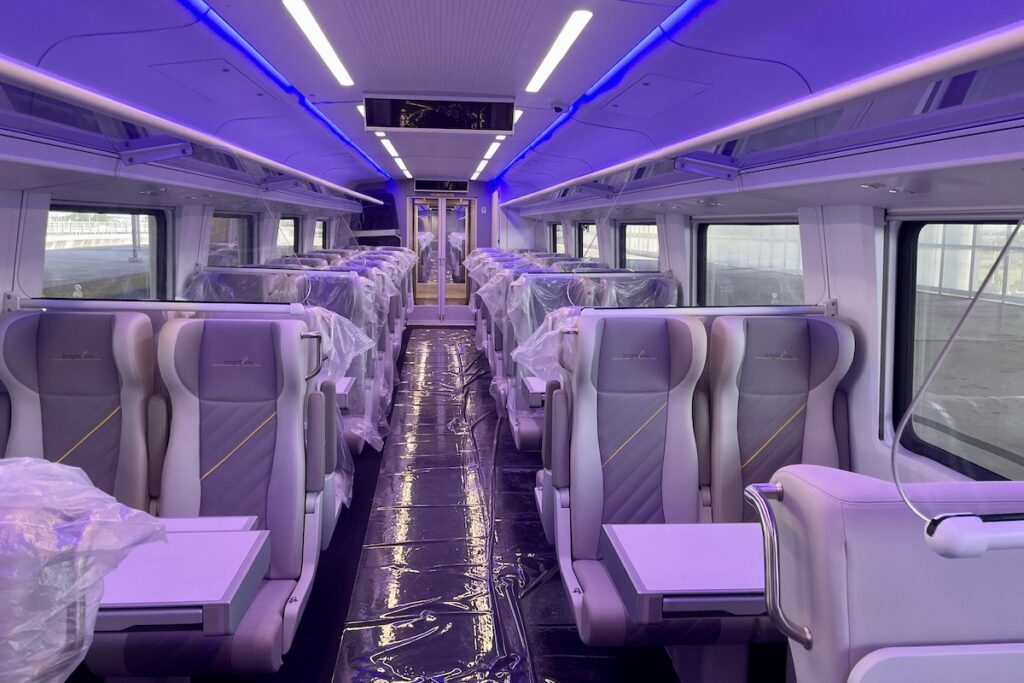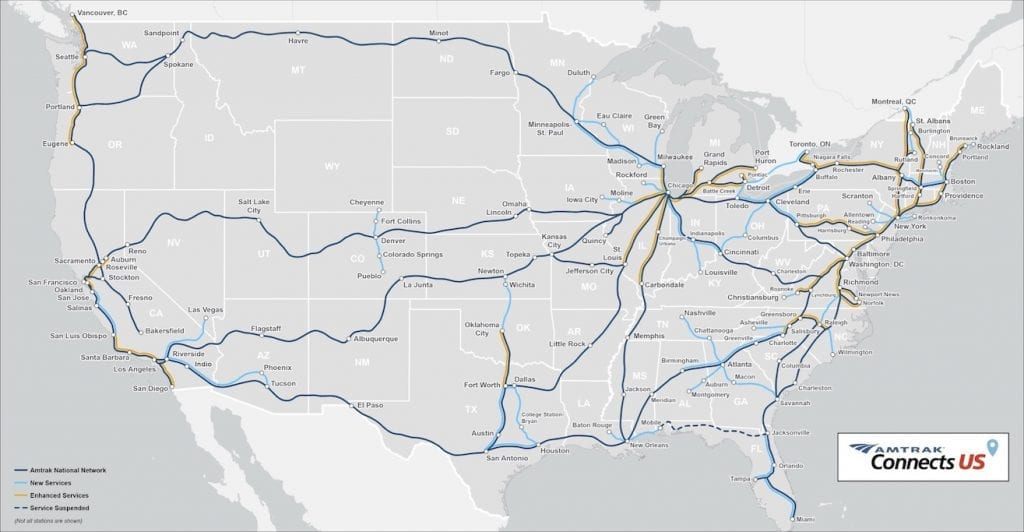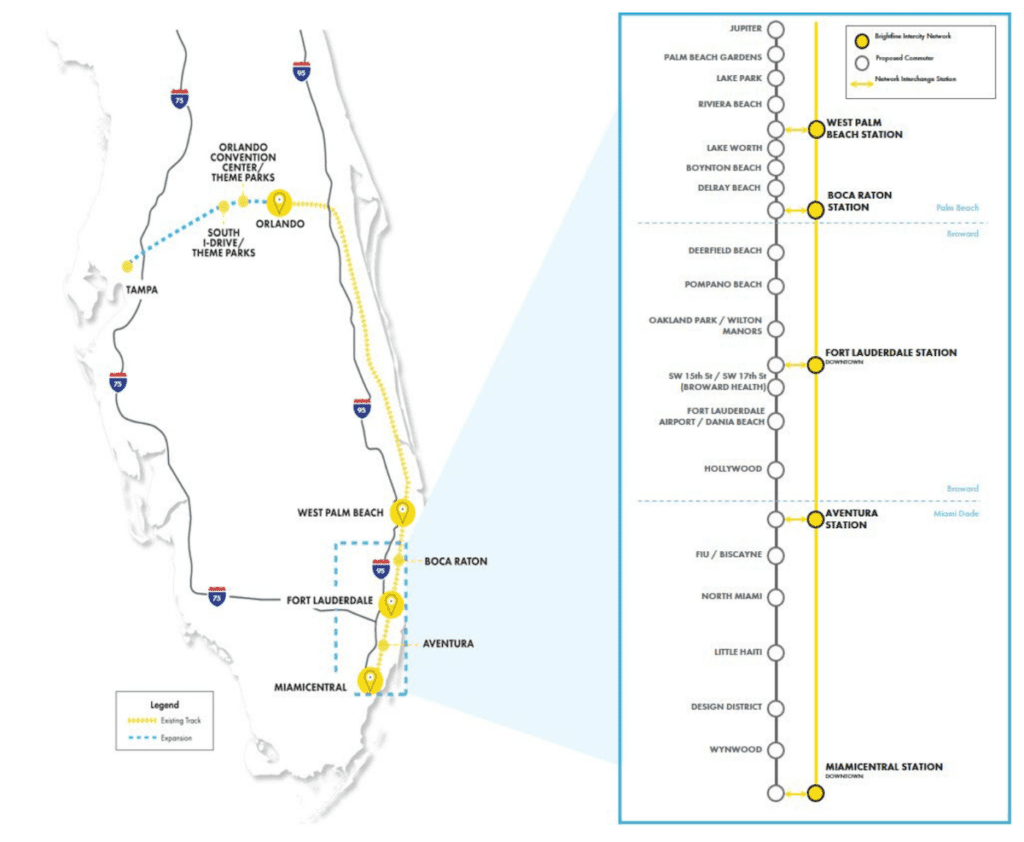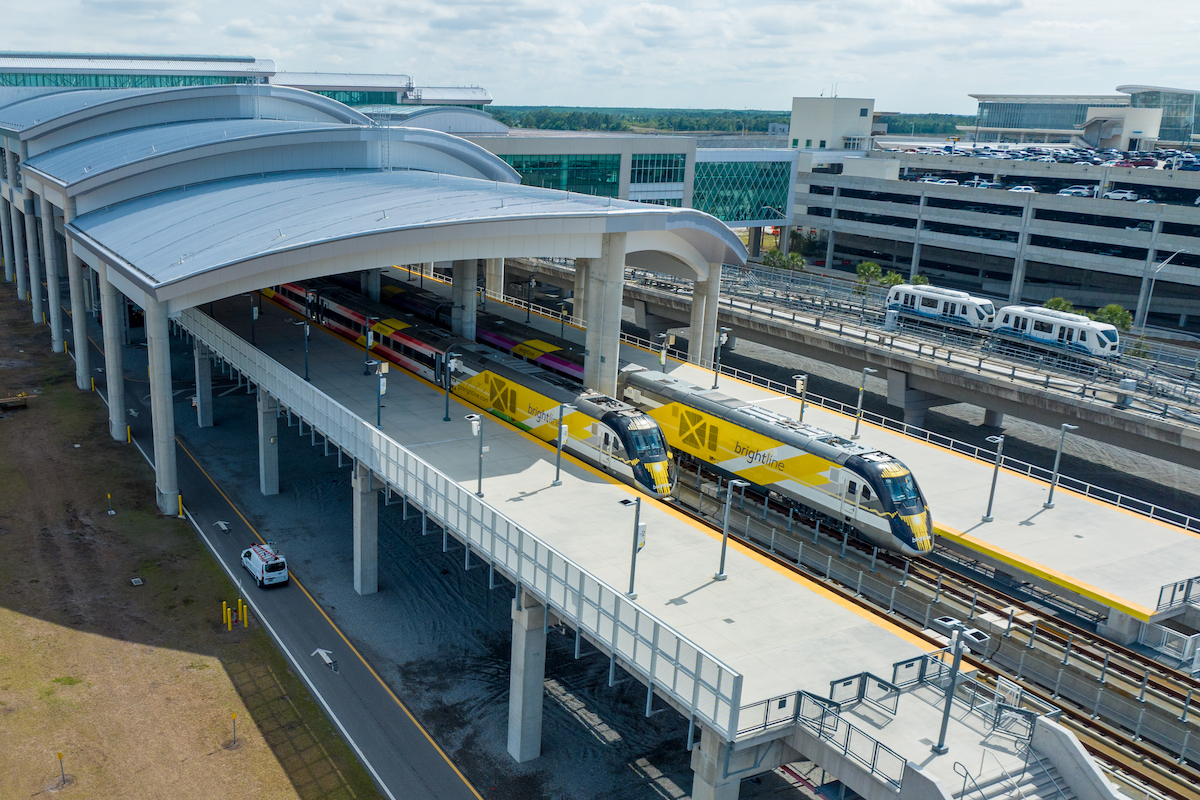Skift Take
America is not known for its fast or nice trains. Brightline wants to change that with its new train to Orlando.
Speeding through central Florida’s flat scrubland east of Orlando is America’s next big passenger train.
That scrubland is where Brightline trains begin carrying passengers between Miami and Orlando on Friday. The 235-mile trip, which is roughly the distance between New York and Washington, D.C., takes as little as 3 hours and 15 minutes in trains running at up to 125 miles per hour — higher-speed but not high-speed rail by global standards — and with no risk of traffic jams. Fares between the cities start as low as $79 one way for adults.
“We believe this is the blueprint for intercity passenger rail around the country,” Brightline President Patrick Goddard said. “We’ve said that many times but now the evidence is there.”
The $6 billion rail line is the first newly built private intercity passenger rail service in the U.S. since before the formation of Amtrak some 50 years ago. And it comes in one of the country’s bastions of car culture: Florida.
“It was almost a moon landing in 2018” when Brightline’s South Florida line opened, Rail Passengers Association CEO Jim Mathews said.
The U.S., simply put, has not invested in intercity passenger rail — whether publicly or privately — in a meaningful way in decades. The infrastructure used by Amtrak’s Northeast Corridor, the busiest in the country, is more than a hundred years old and critical choke points, like the tunnels under the Hudson River between New York and New Jersey, are only now — in 2023 — getting significant federal dollars for renewal and expansion. Those funds come from the Bipartisan Infrastructure Law that President Biden signed in 2021.
At the same time, China has spent tens-of-billions of dollars building out the world’s largest high-speed rail network. And long-time rail leaders like France, Germany, and Japan continue to invest and expand their networks.
“The U.S. is, quite possibly, the most single attractive rail market in the world that doesn’t really have much of a rail market other than the Northeast Corridor today,” Fortress Investment co-founder and Principal Wes Edens said during a Washington Post Live event last year. “Given the dimensions of the country, the economic prosperity, it’s a very compelling opportunity for folks.”
Fortress owns Brightline and the tracks its trains runs on, the Florida East Coast Railway that stretches from Miami to Jacksonville along the state’s Atlantic coast.
And, so far, Edens has been proven correct even among car-loving Floridians. Ridership between Miami and West Palm Beach was up 50% year-over-year to 149,821 passengers in August. That makes Brightline the second busiest intercity passenger rail corridor in the country. The busiest, Amtrak’s Northeast Corridor, carried an average of 770,000 monthly passengers during the year ending in September 2022, and the third busiest, Amtrak’s Pacific Surfliner, an average of 136,000 monthly passengers.
Convincing Americans to Ride the Train
“It’s a game changer, particularly for our international travelers,” Visit Florida CEO Dana Young said of Brightline. The tourism agency expects many foreign visitors, whom Young said are “thrilled” about the new rail line, to incorporate it into their trips to the state.
That’s good news for Brightline, which aims to carry 7.9 million riders in just two short years, or by 2025, according to a September bond prospectus. That projection includes roughly 4.3 million “long-distance” travelers between South Florida and Orlando, and 3.7 million within South Florida. Only about 15% of long-distance riders are expected to be foreign visitors, while Florida residents will make up the bulk — 65% — of people on trains.
Brightline carried 1.2 million passengers last year. And, year-to-date through August, passenger numbers were already up 68% to 1.3 million.
There are a total of 35 million trips annually between South Florida and Orlando, according to Brightline’s estimates. The vast majority of those are made by car.
Asked about Brightline’s ridership targets, Goddard said meeting them is a three-fold effort: One, continuing to expand the railroad’s presence in South Florida. Two, opening the extension to Orlando, which occurs Friday. And three, increasing the capacity of trains to 372 passengers with new carriages in around 2025, from 240 passengers today. Brightline, like all railroads with multiple stops, can expect to sell each seat more than once; a multiple that Goddard said is “four or five times” within South Florida.
We’ve “penetrated [our] biggest source market pretty well by now, and all [we’re] doing now is telling them ‘I can take you to Orlando,'” Goddard said referring to South Florida residents, which make up a plurality of Brightline’s ridership targets. “It’s not like starting from zero.”
Foreign visitors are a small percentage of Brightline’s ridership expectations simply because of the frequency of their trips, maybe once or twice a year, versus a Florida resident who could ride the train any time, Goddard said.

Also important to getting people on the train, and out of their cars, is customer experience. Goddard, who came from the hospitality industry, has focused on everything from the design of Brightline’s train stations to the food and amenities available on the train.
“We are at the intersection of transportation and hospitality,” he said. “We know it has to be a great experience to get people to not drive their car.”
Of course Brightline, as a private company, needs to turn a profit and charges fees for many of those amenities. Based on the numbers provided to bond investors, the railroad forecasts profits on the operational level from next year. It also generates revenue from property developments around its train stations.
Opposition
Not everyone is excited about Brightline. Counties along the central Florida coast, also known as the Treasure Coast, that trains will pass through but not stop in between Miami and Orlando filed multiple lawsuits over the past decade to stop the railroad. Most of the lawsuits focused on environmental concerns with having numerous trains a day pass through their communities, as well as questions over the legality of using certain tax-exempt funding mechanisms.
“I think the government is authorizing improper financing and thus misusing taxpayer dollars on behalf of an inherently unsafe and likely unsuccessful venture,” Citizens Against Rail Expansion in Florida member Robert Crandall told a House subcommittee on Brightline, then known as All Aboard Florida, in 2018. Crandall, a resident of the Treasure Coast region at the time, also happened to be the CEO and chairman of American Airlines from 1985 through 1998.
Despite Crandall’s testimony and other opposition, Brightline settled the lawsuits with Treasure Coast jurisdictions. Those settlements included commitments to make additional safety investments around its train tracks and, in the future, build a new station on the section of coast that includes Port St. Lucie and Vero Beach.
Other complaints about Brightline are the high number of crashes between its trains and vehicles in South Florida. In most instances, those have been attributed to drivers that ignored or otherwise went around railroad track crossing barriers. Brightline and local jurisdictions have agreed to invest more in warnings and deterrents to drivers at crossings in South Florida.
Rail Renaissance
Brightline’s opening comes amid something of an intercity rail renaissance in the U.S. Amtrak has a multi-billion-dollar expansion plan known as Connect U.S. that calls for adding passenger train service to 160 communities across the country. Those plans include lines that have already opened, for example to Burlington, Vt., as well as ones that are still in the early stages of development, like between Atlanta and Savannah.

Amtrak’s expansion plans include expanded passenger service between Orlando and Miami, albeit along a different corridor than Brightline’s trains run. A spokesperson for the national railroad was unavailable to comment on whether Amtrak continues to pursue expanded Miami-Orlando service given the new private line.
Asked if Brightline was an example that Amtrak could follow for its own expansion plans, the Rail Passengers Association’s Mathews said no and called the railroads “two different things.” Amtrak is a subsidized national railroad that should serve both large and small cities, even if that means losing money, he said. Brightline is a private operator that, while an important part of expanding passenger rail service in the U.S., is a model that only works where there is enough travel demand to turn a profit.
“If we only serve the parts of the country that are profitable, we are once again consigning rural America to flyover or zip-through country,” Mathews said.
Other places where Brightline’s model could work include between Las Vegas and Southern California where Fortress’ Brightline West is already developing a new high-speed rail line, he said. Also between the big four Texas cities of Austin, Dallas, Houston, and San Antonio where Texas Central is working on a new line. Even in the Pacific Northwest between Seattle and Portland, Ore., that some might say has terrain too treacherous for a private rail operator to profitably invest, could potentially support a Brightline-like rail line.
The U.S. isn’t the only country investing in intercity passenger rail. Heightened concern over the climate crisis has prompted many countries, particularly those in Europe, to look at ways to discourage air travel and get more people to take the train. France has gone as far as to ban certain domestic flights on routes where trains make the journey in two-and-a-half hours or less. The law has only forced the cancellation of three airline routes but Air France CEO Anne Rigail has said it is driving broader changes in travel patterns, particularly among French corporates.
And last year Germany launched the so-called 9-Euro Ticket – about $10 – to encourage people to take more local and regional trains. It proved very successful even though it did not include the country’s high-speed ICE trains.
Whether Brightline prompts airlines to cancel flights remains to be seen. There are an average of 16 flights a day scheduled between Orlando and the three main South Florida airports — Fort Lauderdale, Miami, and West Palm Beach — in October, according to Cirium Diio data. And the number is actually up — not down — from an average of 14 flights a day in October 2019.
Next Stop: Las Vegas
Brightline’s plans do not end with service to Orlando, where its terminus is a new station adjacent to the airport’s new Terminal C. Planning for a 90-mile extension to Tampa that will also serve Orlando’s busy theme parks is already underway. Goddard said they do not have a firm timeline for the project, which requires additional funds to be raised.
“Once Miami, Orlando, and Tampa are linked by high-speed rail, that’s really a game changer,” Visit Florida’s Young said. The cities also represent the state’s three largest metropolitan areas.

There are also plans for two new stations on Brightline’s existing line along, as mentioned, the Treasure Coast and in Brevard County, which is home to Cocoa Beach and Cape Canaveral.
But Fortress and Brightline have their sights set on an even bigger prize: A true high-speed rail line connecting Las Vegas and Rancho Cucamonga, Calif., about 40 miles west of downtown Los Angeles. That project, the aforementioned $12 billion Brightline West line, has the necessary federal approvals in hand, and land for the tracks and stations secured for construction to begin as early as the end of the year. The last piece of the puzzle is funding, which will come from several sources including private investors, tax-free bonds, and, potentially, a $3.75 billion federal grant.
Fortress’ expects a decision on that federal grant within the next month or so, Goddard said.
Edens, who said he first had the idea for Brightline’s Florida line after reading about Henry Flagler who built the original line in 1896, is, if nothing else, extremely bullish on his firm’s multi-billion-dollar investments in passenger rail.
Train travel is “better. It’s more fun. It’s more enjoyable. It’s a way for you to be productive while you travel. So I think it’s got a lot of the checks in the right column, and we think it’s going to be very successful here,” he said last year.
The Daily Newsletter
Our daily coverage of the global travel industry. Written by editors and analysts from across Skift’s brands.
Have a confidential tip for Skift? Get in touch
Tags: amtrak, Brightline, florida, ground transportation, trains
Photo credit: Brightline begins running passenger trains between a new station at the Orlando airport and Miami on Friday. (Brightline) Brightline
